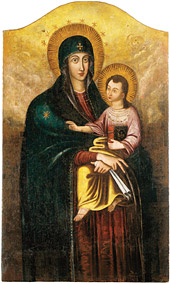Painting of Our Lady of Šiluva
The image of Our Lady of Šiluva with the Child Jesus was painted in the first half of the 17th century and quickly gained fame for special graces. The painting is of the Hodogetria icon type. Its prototype is the icon of Our Lady of the Snows in the Roman Basilica of Saint Mary Major. That means the Šiluva painting is a copy of one of the world’s most famous and most widely known icons of Mary. It was only in 1569 that Pope Pius V authorized making copies of the Roman icon, widely known as the Salus populi romani. Most likely this image of the Madonna in the Byzantine Hodegetria tradition was chosen deliberately for Šiluva in order to stress the petition of Mary during the apparition that her Son be worshipped here.
The figures of Mary and the Child are clothed with a cover of precious metals fabricated in 1674 by the famous Königsberg goldsmith Lawrence Hoffman from the abundant votive offerings left by pilgrims. With the authorization of Pope Pius VI, the painting was solemnly crowned on September 8, 1786.
Devotion to this painting of Mary and Jesus at Šiluva has given rise not only to many votive offerings and to a rich cover, but also to abundant and varied pious practices, including prayers, hymns and a tradition of circling the altar at which the image hangs on one’s knees.
Extensive studies of the painting were conducted during 2002 and 2003 at the Lithuanian Art Museum’s Pranas Gudynas Restoration Centre in the context of restoration work that revived the image’s original charm and revealed its true artistic value.








